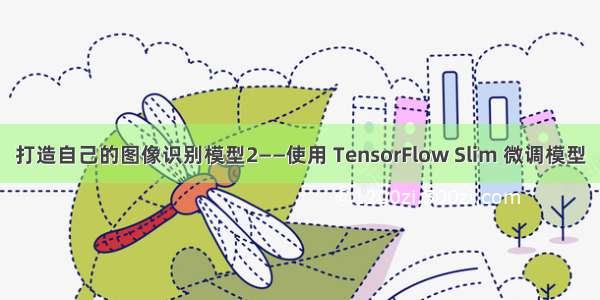
最近在搞自己的深度学习图像识别模型。这是第二步
本文主要讲解在现有常用模型基础上,如何微调模型,减少训练时间,同时保持模型检测精度。
主要参考书籍《21个项目玩转深度学习:基于TensorFlow的实践详解》
主要参考原文:/moyu123456789/article/details/83956366
书籍中有代码错误,解决办法参考:/c1052/article/details/81325394
一、下载slim包
首先介绍下Slim这个Google公布的图像分类工具包,可在github链接:/csq1052/models
中找到slim包。
上面这个链接目录下主要包含:
official models(这个是用Tensorflow高层API做的例子模型集,建议初学者可尝试);
research models(这个是很多研究者利用tensorflow做的模型集,这个不是官方提供的,是研究者个人在维护的);
samples folder(包含代码片段和小的模型用以表述tensorflow特性,包含以博客形式存在的代码呈现);
而我说的slim工具包就在research文件夹下。
二、Slim库结构
表 3-2 中只列出了 TensorFlow Slim 中最重要的几个文件以及文件夹的 作用。 其他还高少量文件和文件夹,如果读者对官仰的作用感兴趣,可以自 行参阅真文档。
3.数据准备
1)将数据分为训练集和验证集
本实验使用的时作者书里提供的卫星拍摄图片数据集。原始数据集保存路径如下,其中train中为训练数据集,validation中为测试数据集。可以看出共有wood(树林)、water(水)、rock(岩石)、wetland(湿地)、glacier(冰川)、urban(城市)这六类图片.
在data_prepare文件夹下有个pic的文件夹,该文件夹中又包含train文件夹和validation文件夹;在train文件夹中又包含wood,water,rock,wetland,glacier,urban文件夹,这6个文件夹中分别包含各自类型图像800张,尺寸大致为256x256;
同样在validation中也包含那6个文件夹,各目录下存放了200张图像;
data_prepare/pic/train/wood/water/rock/wetland/glacier/urban/validation/wood/water/rock/wetland/glacier/urban/
图片长什么样呢?对于本例中使用的6类数据集个随意取一张来看看:
2)将数据转换为tfrecord格式数据
对于大数据,TensorFlow中都需要转换成TFRecord格式的文件,TFRecord文件同样是以二进制进行存储数据的,适合以串行的方式读取大批量数据。其优势是能更好的利用内存,更方便地复制和移动,这更符合TensorFlow执行引擎的处理方式。通常数据转换成tfrecord格式需要写个小程序将每一个样本组装成protocol buffer定义的Example的对象,序列化成字符串,再由tf.python_io.TFRecordWriter写入文件即可。
python data_convert.py -t pic/
–train-shards 2
–validation-shards 2
–num-threads 2
–dataset-name satellite
指令解释如下:
-t pic/ 是指要转换格式的图像文件存放在pic文件夹下;
–train-shards 2是指将训练图像生成的tfrecord文件分成2份(考虑数据存储的方便,具体分成几份才合理请百度吧,默认是2份)
–validation-shards 2是指将验证图像生成的tfrecord文件分成2份(默认2)
–num-threads 2线程数(默认2,注意线程数必须要能整除 train-shards 和 validation-shards,来保证每个线程处理的数据块数是相同的)
–dataset-name satellite数据集名,默认为satellite(根据读者自己的数据集更改,何大神用的是卫星航拍图,给生成的数据集起一个名字。这里将数据集起名 叫“satellite'’,最后生成文件的开头就是 satellite_train 和 satellite_validation)
在data_prepare文件夹下,存放有data_convert.py文件,该文件可将图片转换为tfrecord格式。data_convert.py文件代码如下:
# coding:utf-8from __future__ import absolute_importimport argparseimport osimport loggingfrom src.tfrecord import maindef parse_args():parser = argparse.ArgumentParser()parser.add_argument('-t', '--tensorflow-data-dir', default='pic/')parser.add_argument('--train-shards', default=2, type=int)parser.add_argument('--validation-shards', default=2, type=int)parser.add_argument('--num-threads', default=2, type=int)parser.add_argument('--dataset-name', default='satellite', type=str)return parser.parse_args()if __name__ == '__main__':logging.basicConfig(level=logging.INFO)args = parse_args()args.tensorflow_dir = args.tensorflow_data_dirargs.train_directory = os.path.join(args.tensorflow_dir, 'train')args.validation_directory = os.path.join(args.tensorflow_dir, 'validation')args.output_directory = args.tensorflow_dirargs.labels_file = os.path.join(args.tensorflow_dir, 'label.txt')if os.path.exists(args.labels_file) is False:logging.warning('Can\'t find label.txt. Now create it.')all_entries = os.listdir(args.train_directory)dirnames = []for entry in all_entries:if os.path.isdir(os.path.join(args.train_directory, entry)):dirnames.append(entry)with open(args.labels_file, 'w') as f:for dirname in dirnames:f.write(dirname + '\n')main(args)
读者可根据作者的数据存放目录结构存放数据,然后根据自己的数据集更改名字;其中上面这个.py文件调用了src文件夹中的tfrecord.py文件(其源码如下);
# coding:utf-8# Copyright Google Inc. All Rights Reserved.## Licensed under the Apache License, Version 2.0 (the "License");# you may not use this file except in compliance with the License.# You may obtain a copy of the License at##/licenses/LICENSE-2.0## Unless required by applicable law or agreed to in writing, software# distributed under the License is distributed on an "AS IS" BASIS,# WITHOUT WARRANTIES OR CONDITIONS OF ANY KIND, either express or implied.# See the License for the specific language governing permissions and# limitations under the License.# =============================================================================="""Converts image data to TFRecords file format with Example protos.The image data set is expected to reside in JPEG files located in thefollowing directory structure.data_dir/label_0/image0.jpegdata_dir/label_0/image1.jpg...data_dir/label_1/weird-image.jpegdata_dir/label_1/my-image.jpeg...where the sub-directory is the unique label associated with these images.This TensorFlow script converts the training and evaluation data intoa sharded data set consisting of TFRecord filestrain_directory/train-00000-of-01024train_directory/train-00001-of-01024...train_directory/train-00127-of-01024andvalidation_directory/validation-00000-of-00128validation_directory/validation-00001-of-00128...validation_directory/validation-00127-of-00128where we have selected 1024 and 128 shards for each data set. Each recordwithin the TFRecord file is a serialized Example proto. The Example protocontains the following fields:image/encoded: string containing JPEG encoded image in RGB colorspaceimage/height: integer, image height in pixelsimage/width: integer, image width in pixelsimage/colorspace: string, specifying the colorspace, always 'RGB'image/channels: integer, specifying the number of channels, always 3image/format: string, specifying the format, always'JPEG'image/filename: string containing the basename of the image filee.g. 'n01440764_10026.JPEG' or 'ILSVRC_val_00000293.JPEG'image/class/label: integer specifying the index in a classification layer. start from "class_label_base"image/class/text: string specifying the human-readable version of the labele.g. 'dog'If you data set involves bounding boxes, please look at build_imagenet_data.py."""from __future__ import absolute_importfrom __future__ import divisionfrom __future__ import print_functionfrom datetime import datetimeimport osimport randomimport sysimport threadingimport numpy as npimport tensorflow as tfimport loggingdef _int64_feature(value):"""Wrapper for inserting int64 features into Example proto."""if not isinstance(value, list):value = [value]return tf.train.Feature(int64_list=tf.train.Int64List(value=value))def _bytes_feature(value):value=pat.as_bytes(value)return tf.train.Feature(bytes_list=tf.train.BytesList(value=[value]))def _convert_to_example(filename, image_buffer, label, text, height, width):"""Build an Example proto for an example.Args:filename: string, path to an image file, e.g., '/path/to/example.JPG'image_buffer: string, JPEG encoding of RGB imagelabel: integer, identifier for the ground truth for the networktext: string, unique human-readable, e.g. 'dog'height: integer, image height in pixelswidth: integer, image width in pixelsReturns:Example proto"""colorspace = 'RGB'channels = 3image_format = 'JPEG'example = tf.train.Example(features=tf.train.Features(feature={'image/height': _int64_feature(height),'image/width': _int64_feature(width),'image/colorspace': _bytes_feature(colorspace),'image/channels': _int64_feature(channels),'image/class/label': _int64_feature(label),'image/class/text': _bytes_feature(text),'image/format': _bytes_feature(image_format),'image/filename': _bytes_feature(os.path.basename(filename)),'image/encoded': _bytes_feature(image_buffer)}))return exampleclass ImageCoder(object):"""Helper class that provides TensorFlow image coding utilities."""def __init__(self):# Create a single Session to run all image coding calls.self._sess = tf.Session()# Initializes function that converts PNG to JPEG data.self._png_data = tf.placeholder(dtype=tf.string)image = tf.image.decode_png(self._png_data, channels=3)self._png_to_jpeg = tf.image.encode_jpeg(image, format='rgb', quality=100)# Initializes function that decodes RGB JPEG data.self._decode_jpeg_data = tf.placeholder(dtype=tf.string)self._decode_jpeg = tf.image.decode_jpeg(self._decode_jpeg_data, channels=3)def png_to_jpeg(self, image_data):return self._sess.run(self._png_to_jpeg,feed_dict={self._png_data: image_data})def decode_jpeg(self, image_data):image = self._sess.run(self._decode_jpeg,feed_dict={self._decode_jpeg_data: image_data})assert len(image.shape) == 3assert image.shape[2] == 3return imagedef _is_png(filename):"""Determine if a file contains a PNG format image.Args:filename: string, path of the image file.Returns:boolean indicating if the image is a PNG."""return '.png' in filenamedef _process_image(filename, coder):"""Process a single image file.Args:filename: string, path to an image file e.g., '/path/to/example.JPG'.coder: instance of ImageCoder to provide TensorFlow image coding utils.Returns:image_buffer: string, JPEG encoding of RGB image.height: integer, image height in pixels.width: integer, image width in pixels."""# Read the image file.with open(filename, 'rb') as f: # need change r to rbimage_data = f.read()# Convert any PNG to JPEG's for consistency.if _is_png(filename):logging.info('Converting PNG to JPEG for %s' % filename)image_data = coder.png_to_jpeg(image_data)# Decode the RGB JPEG.image = coder.decode_jpeg(image_data)# Check that image converted to RGBassert len(image.shape) == 3height = image.shape[0]width = image.shape[1]assert image.shape[2] == 3return image_data, height, widthdef _process_image_files_batch(coder, thread_index, ranges, name, filenames,texts, labels, num_shards, command_args):"""Processes and saves list of images as TFRecord in 1 thread.Args:coder: instance of ImageCoder to provide TensorFlow image coding utils.thread_index: integer, unique batch to run index is within [0, len(ranges)).ranges: list of pairs of integers specifying ranges of each batches toanalyze in parallel.name: string, unique identifier specifying the data setfilenames: list of strings; each string is a path to an image filetexts: list of strings; each string is human readable, e.g. 'dog'labels: list of integer; each integer identifies the ground truthnum_shards: integer number of shards for this data set."""# Each thread produces N shards where N = int(num_shards / num_threads).# For instance, if num_shards = 128, and the num_threads = 2, then the first# thread would produce shards [0, 64).num_threads = len(ranges)assert not num_shards % num_threadsnum_shards_per_batch = int(num_shards / num_threads)shard_ranges = np.linspace(ranges[thread_index][0],ranges[thread_index][1],num_shards_per_batch + 1).astype(int)num_files_in_thread = ranges[thread_index][1] - ranges[thread_index][0]counter = 0for s in range(num_shards_per_batch): #xrange used only in python 2.X ;so use range instend by csq# Generate a sharded version of the file name, e.g. 'train-00002-of-00010'shard = thread_index * num_shards_per_batch + soutput_filename = '%s_%s_%.5d-of-%.5d.tfrecord' % (command_args.dataset_name, name, shard, num_shards)output_file = os.path.join(command_args.output_directory, output_filename)writer = tf.python_io.TFRecordWriter(output_file)shard_counter = 0files_in_shard = np.arange(shard_ranges[s], shard_ranges[s + 1], dtype=int)for i in files_in_shard:filename = filenames[i]label = labels[i]text = texts[i]image_buffer, height, width = _process_image(filename, coder)example = _convert_to_example(filename, image_buffer, label,text, height, width)writer.write(example.SerializeToString())shard_counter += 1counter += 1if not counter % 1000:logging.info('%s [thread %d]: Processed %d of %d images in thread batch.' %(datetime.now(), thread_index, counter, num_files_in_thread))sys.stdout.flush()writer.close()logging.info('%s [thread %d]: Wrote %d images to %s' %(datetime.now(), thread_index, shard_counter, output_file))sys.stdout.flush()shard_counter = 0logging.info('%s [thread %d]: Wrote %d images to %d shards.' %(datetime.now(), thread_index, counter, num_files_in_thread))sys.stdout.flush()def _process_image_files(name, filenames, texts, labels, num_shards, command_args):"""Process and save list of images as TFRecord of Example protos.Args:name: string, unique identifier specifying the data setfilenames: list of strings; each string is a path to an image filetexts: list of strings; each string is human readable, e.g. 'dog'labels: list of integer; each integer identifies the ground truthnum_shards: integer number of shards for this data set."""assert len(filenames) == len(texts)assert len(filenames) == len(labels)# Break all images into batches with a [ranges[i][0], ranges[i][1]].spacing = np.linspace(0, len(filenames), command_args.num_threads + 1).astype(np.int)ranges = []for i in range(len(spacing) - 1): #xrange used only in python 2.X ;so use range instend by csqranges.append([spacing[i], spacing[i + 1]])# Launch a thread for each batch.logging.info('Launching %d threads for spacings: %s' % (command_args.num_threads, ranges))sys.stdout.flush()# Create a mechanism for monitoring when all threads are finished.coord = tf.train.Coordinator()# Create a generic TensorFlow-based utility for converting all image codings.coder = ImageCoder()threads = []for thread_index in range(len(ranges)): #xrange used only in python 2.X ;so use range instend by csqargs = (coder, thread_index, ranges, name, filenames,texts, labels, num_shards, command_args)t = threading.Thread(target=_process_image_files_batch, args=args)t.start()threads.append(t)# Wait for all the threads to terminate.coord.join(threads)logging.info('%s: Finished writing all %d images in data set.' %(datetime.now(), len(filenames)))sys.stdout.flush()def _find_image_files(data_dir, labels_file, command_args):"""Build a list of all images files and labels in the data set.Args:data_dir: string, path to the root directory of images.Assumes that the image data set resides in JPEG files located inthe following directory structure.data_dir/dog/another-image.JPEGdata_dir/dog/my-image.jpgwhere 'dog' is the label associated with these images.labels_file: string, path to the labels file.The list of valid labels are held in this file. Assumes that the filecontains entries as such:dogcatflowerwhere each line corresponds to a label. We map each label contained inthe file to an integer starting with the integer 0 corresponding to thelabel contained in the first line.Returns:filenames: list of strings; each string is a path to an image file.texts: list of strings; each string is the class, e.g. 'dog'labels: list of integer; each integer identifies the ground truth."""logging.info('Determining list of input files and labels from %s.' % data_dir)unique_labels = [l.strip() for l in tf.gfile.FastGFile(labels_file, 'r').readlines()]labels = []filenames = []texts = []# Leave label index 0 empty as a background class."""非常重要,这里我们调整label从0开始以符合定义"""label_index = command_args.class_label_base# Construct the list of JPEG files and labels.for text in unique_labels:jpeg_file_path = '%s/%s/*' % (data_dir, text)matching_files = tf.gfile.Glob(jpeg_file_path)labels.extend([label_index] * len(matching_files))texts.extend([text] * len(matching_files))filenames.extend(matching_files)if not label_index % 100:logging.info('Finished finding files in %d of %d classes.' % (label_index, len(labels)))label_index += 1# Shuffle the ordering of all image files in order to guarantee# random ordering of the images with respect to label in the# saved TFRecord files. Make the randomization repeatable.shuffled_index = list(range(len(filenames))) #add list() by cikyrandom.seed(12345)random.shuffle(shuffled_index)filenames = [filenames[i] for i in shuffled_index]texts = [texts[i] for i in shuffled_index]labels = [labels[i] for i in shuffled_index]logging.info('Found %d JPEG files across %d labels inside %s.' %(len(filenames), len(unique_labels), data_dir))# print(labels)return filenames, texts, labelsdef _process_dataset(name, directory, num_shards, labels_file, command_args):"""Process a complete data set and save it as a TFRecord.Args:name: string, unique identifier specifying the data set.directory: string, root path to the data set.num_shards: integer number of shards for this data set.labels_file: string, path to the labels file."""filenames, texts, labels = _find_image_files(directory, labels_file, command_args)_process_image_files(name, filenames, texts, labels, num_shards, command_args)def check_and_set_default_args(command_args):if not(hasattr(command_args, 'train_shards')) or command_args.train_shards is None:command_args.train_shards = 5if not(hasattr(command_args, 'validation_shards')) or command_args.validation_shards is None:command_args.validation_shards = 5if not(hasattr(command_args, 'num_threads')) or command_args.num_threads is None:command_args.num_threads = 5if not(hasattr(command_args, 'class_label_base')) or command_args.class_label_base is None:command_args.class_label_base = 0if not(hasattr(command_args, 'dataset_name')) or command_args.dataset_name is None:command_args.dataset_name = ''assert not command_args.train_shards % command_args.num_threads, ('Please make the command_args.num_threads commensurate with command_args.train_shards')assert not command_args.validation_shards % command_args.num_threads, ('Please make the command_args.num_threads commensurate with ''command_args.validation_shards')assert command_args.train_directory is not Noneassert command_args.validation_directory is not Noneassert command_args.labels_file is not Noneassert command_args.output_directory is not Nonedef main(command_args):"""command_args:需要有以下属性:command_args.train_directory 训练集所在的文件夹。这个文件夹下面,每个文件夹的名字代表label名称,再下面就是图片。command_args.validation_directory 验证集所在的文件夹。这个文件夹下面,每个文件夹的名字代表label名称,再下面就是图片。command_args.labels_file 一个文件。每一行代表一个label名称。command_args.output_directory 一个文件夹,表示最后输出的位置。command_args.train_shards 将训练集分成多少份。command_args.validation_shards 将验证集分成多少份。command_args.num_threads 线程数。必须是上面两个参数的约数。command_args.class_label_base 很重要!真正的tfrecord中,每个class的label号从多少开始,默认为0(在models/slim中就是从0开始的)command_args.dataset_name 字符串,输出的时候的前缀。图片不可以有损坏。否则会导致线程提前退出。"""check_and_set_default_args(command_args)logging.info('Saving results to %s' % command_args.output_directory)# Run it!_process_dataset('validation', command_args.validation_directory,command_args.validation_shards, command_args.labels_file, command_args)_process_dataset('train', command_args.train_directory,command_args.train_shards, command_args.labels_file, command_args)
这个源码与何大神提供有差异,考虑本人用的是python3,(何大神用的应该是python2),所以如不做更改会报一些错误。
直接运行
python data_convert.py -t pic/
–train-shards 2
–validation-shards 2
–num-threads 2
–dataset-name satellite
可能会报如下错误:
\data_prepare\src\tfrecord.py", line 341, in _find_image_files
random.shuffle(shuffled_index)
File “F:\Python36\lib\random.py”, line 275, in shuffle
x[i], x[j] = x[j], x[i]
TypeError: ‘range’ object does not support item assignment
UnicodeDecodeError: ‘gbk’ codec can’t decode byte 0xff in position 0: illegal multibyte sequence
解决方法是做如下几处做更改(我上面给的tfrecord.py代码是做了更改后的):
解决方法
//第一def _bytes_feature(value):"""Wrapper for inserting bytes features into Example proto."""value=pat.as_bytes(value)//这行需要添加 (作者给的代码这行没有)return tf.train.Feature(bytes_list=tf.train.BytesList(value=[value]))//第二def _process_image(filename, coder):with open(filename, 'rb') as f://这里需要加个b(作者给的源码是‘r’)image_data = f.read()//第三xrange需要都改为range //第四_find_image_files:shuffled_index = list(range(len(filenames)))//这里加上了list (百度了下说python3中range不返回数组对象,而是返回range对象)//第五你的项目路径最好不要有中文,嗯中文路径很多问题的你懂的,拼音也比中文好。
昨天写到这里
/c1052/article/details/81325394
书中代码错误多多,主要参考两篇博客,自己最终运行出来了 5.问题总结 1)对于不支持GPU训练的设备,会遇到下面问题: 最简单的修改方法是只在CPU上进行训练,在训练指令中增加参数:–clone_on_cpu=True 表示只在cpu上运行。 2)对于运行中爆出的下面日志的问题,其实不影响结果。 -11-11 09:11:10.323000: I tensorflow/core/platform/:141] Your CPU supports instructions that this TensorFlow binary was not compiled to use: AVX2 但是如果要修改这个问题的话,可以在对应的python文件开头增加下面两行代码可以解决该问题。 import os os.environ[‘TF_CPP_MIN_LOG_LEVEL’] = ‘2’ 3)本书中的代码和我使用的TensorFlow版本不一样,直接运行代码会报好几个问题,修改方法来自这个链接:














